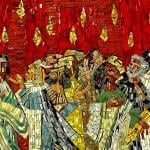One noteworthy element in our new book Authentic Christianity: How Lutheran Theology Speaks to the Postmodern World is our telling the story and drawing on the insights of J. G. Hamann. This 18th century thinker is being hailed today as perhaps the greatest critic of what would become both modernism and postmodernism. The basis of that critique was a very sophisticated application of Lutheran theology.
Johann Georg Hamann (1730–1788) was very influential in his day–having a strong impact on Goethe, Kierkegaard, and C. F. W. Walther–though he has since fallen into obscurity. But he is being rediscovered by intellectual historians and by the “radical orthodox” theologians.
As a young man, Hamann belonged to a circle of German philosophes, champions of the Enlightenment and the Age of Reason. Also in this circle was Hamann’s good friend and fellow Königsberg resident Immanuel Kant. One day, as he was struggling through some personal problems, Hamann started reading the Bible. The Law and Gospel did their work. He experienced a dramatic conversion to Christianity.
His sophisticated, rationalistic friends were concerned by Hamann’s new-found piety. They tried to persuade him to return to the principle of “reason alone.” Reason didn’t bring me to faith, he told them, so reason is unlikely to bring me out of it. But they did their best to convince him to abandon his “irrational” supernatural beliefs. To no avail. Whereupon Hamann responded by addressing their irrational rationalism.
Hamann became what has been called “the most sophisticated critic of the Enlightenment.” His target was the pretension of human beings thinking they have “figured out everything” just by constructing a set of all-encompassing abstract ideas. He wasn’t attacking science. In fact, he was re-directing “the Age of Reason” to science by stressing the importance of empirical experience and physical reality.
The Enlightenment is considered the beginning of Modernism. So his critique of the Enlightenment applies also to the later modernism of the 20th century. Hamann was not opposed to reason–much less was he an “irrationalist” as he would be termed by those who wanted to dismiss him–but he showed that there is no such thing as “reason alone.” He emphasized the importance of language (which introduced the “linguistic” factor into philosophy, which would take many different forms). Also culture and power, anticipating by centuries the postmodernist critics of modernism. The contemporary scholar John Betz believes that Hamann should be mentioned with the reigning “postmodern triumvirate” of Nietzsche, Heidegger, and Derrida.
But Betz also says that Hamann also anticipates and refutes those postmodernists centuries before they lived! Hamann’s friend Kant was not only the culmination of Enlightenment rationalism but also, by stressing knowledge as a mental construction, the one who laid the foundation for postmodernism. Hamann’s “metacritcism” of Kant is considered to be the definitive refutation of Kant’s philosophy. Kant, like similar theorists, ends up “problematizing” ordinary experience–arguing that we can’t really know objective truth, that we should be suspicious of things as they appear, that we need to be skeptical of everything. This mindset doesn’t create knowledge, but rather destroys it and makes it impossible to know anything.
In undermining the “hermeneutics of suspicion,” Hamann was not denying the role of power and the attempt to control people by imposing on them a set of ideas. Hamann excoriated the tyranny of Frederick the Great, who was the great patron of “Enlightenment” ideas. Frederick was the first in a line of “Enlightened” kings of Prussia who would suppress orthodoxy and classical education by creating the liberal state church the “Prussian Union” and the “Prussian model ” of progressive education.
How does Hamann do all of this, and what is his alternative view of the world? Hamann refutes both modernism and postmodernism and offers an alternative by applying Lutheran theology: the Word of God, the Creation, the Incarnation, Justification by faith, Law and Gospel, Christology, the Sacraments, the Two Kingdoms, the Theology of the Cross.
Betz concludes that both Modernism and Postmodernism must end in nihilism. He then says that Hamann’s “post-secular” vision is the only way to avoid nihilism and to go forward past the modern and postmodern dead ends.
Since Hamann’s “post-secular” vision is that of confessional Lutheranism, it would seem that confessional Lutheranism provides the answer to both modernism and postmodernism, is the only way to avoid nihilism, and offers a way to go forward past the modern and postmodern dead ends. That’s pretty much what our book is about.
Hamann is difficult to read. He writes in a dense, allusive, though humorous style. John Kleinig, who turned me on to Hamann through Betz’s book, told me that you almost have to read Hamann in German to understand him. His clearest and most theological work, the London Journals–the account of his conversion–is not even, as far as I know, available in English. I urge you to first approach Hamann through two excellent books about him:
John Betz, After Enlightenment: The Post-Secular Vision of J. G. Hamann.
Oswald Bayer, A Contemporary in Dissent: Johann Georg Hamann as Radical Enlightener. (Bayer, the Lutheran theologian, presents Hamann as a catalyst for the 19th century Confessional revival that would give us C. F. W. Walther and the Lutheran Church Missouri Synod.)
Photo of J. G. Hamann, [Public domain], via Wikimedia Commons














